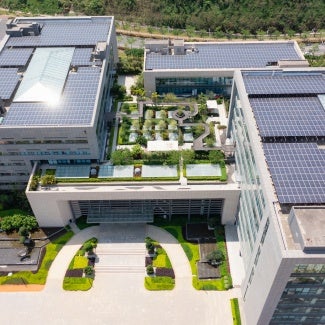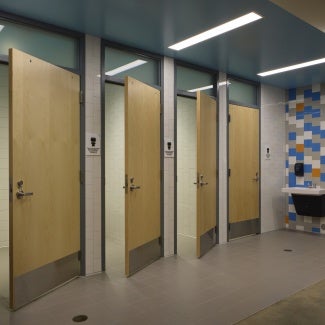Putting sustainability into practice
Author: Deltek
Explore five architecture firm best practices for implementing sustainable designs and specifications and staying on top of evolving sustainability standards and products.

Sustainability best practices
Sustainability is more than just a buzzword. It is a practical part of modern design and can be leveraged in several realistic, impactful ways. However, with an ever-evolving ecosystem of sustainable standards and products—staying on top of best practices can seem daunting to firms.
To help your firm put sustainability into practice, here are five ways to evangelize and execute sustainable designs and specifications in future projects.
Practice 1: Start small, think big
Developing a sustainability-focused practice can be a time-consuming process. So how do you take on climate change within the profession when barriers like staff capacity, client education, and fast-paced schedules hold you back?
Think about starting small yet thinking big. Identify what sustainability means to your practice and set project goals that meet your firm's vision. Make sure that all stakeholders are on board with sustainable design choices. For example, does your firm want to specify a material with a high recycled content percentage? Do you want to invest in more sustainable products to meet the firm's vision?
According to The AIA Architect's Journey to Specification Report, architects consider sustainability throughout the project. However, sustainability is often top of mind during specification, indicating that architects see sustainability as connected to product selection—six in ten firms research sustainability at least 50% of the time when selecting products or materials.
While incorporating sustainability may seem ambitious, owners have a growing interest in developing buildings with products to meet their corporate goals while being environmentally friendly. To meet owners' sustainable building requirements, firms need access to up-to-date product information that showcases a product's sustainability parameters. Providing the most up-to-date content, including sustainability information, allows ease of specification, which fosters a more informed product selection and installation process and, in turn, a better-built environment.
Sustainability strategies will be ever evolving throughout the project due to construction and budget constraints, so it's essential to be adaptable.
Practice 2: Be specific & instructive
A great design should have specifications that serve as an on-site instruction manual for those building the project, clearly stating the design standards you expect. The specifications ensure that the end project matches your design vision.
When specification documents skimp on details, it affects the accuracy of the bid and, down the road, will impact the project schedule and budget. For example, guessing a model number will prevent the contractor from buying the correct product and bringing the design vision to life. It also leads to lost time during construction as the contractor scrambles for a replacement.
That's why coordination—in drawings, specs, and communication—is critical, says Jane Williams, Director of MasterSpec® at Deltek. Work through each section with the design team and ask questions that identify every detail.
Greater specificity means fewer questions, change orders, and RFIs. Getting specific requires coordination and asking questions. Every player on the project, from the architects to the owner, responds differently to drawings versus specs.
According to Gill Letourneau, AIA CSI, Sr. Director of Product Management AECO, Deltek, "an architect must understand all the unique aspects of construction specifications because it dramatically impacts the project's success."
Practice 3: Recognize the possibilities for automation
Developing specifications can be a time-consuming process. Specifications are a large percentage of the contract deliverable, sometimes up to 50%. It's an integral part of the design process, but it can be time-consuming and requires all team members to be involved. Navigating through the multiple phases of design and construction requires the team to work efficiently and accurately.
Automation is key to helping meet today's demanding project schedules and achieve high-quality results without burdening the project team with increased RFIs, change orders, and schedule disruptions. Additionally, with the vast amount of sustainable building products in the market, it takes time to stay current on the latest product offerings.
That's why it's essential to adopt modern specification software and let it do the work for you. In addition, making product comparisons on the salient characteristics of the product and its sustainability levels is essential. Having in-depth product data points around performance, options, and sustainability can foster better-informed product decisions.
Fernand Ricard, CSI, CDT, LEED AP, Associate Principal/Specifier, CallisonRTKL, Inc., shares that “having a single source to view and specify products means greater efficiency. I can focus more on technical concerns of my spec writing and waste less time searching for product data across multiple internet sources.”
Practice 4: Go green with construction materials
Materials are engineered to be more intelligent, more robust, sleeker, and easier on the planet. Architects need to stay up to date on these material innovations to stay competitive. Buildings crafted with well-thought-out, intelligent material selections can solve ongoing challenges, reduce the carbon footprint, and positively impact the environment.
There are many considerations when selecting materials in the built environment. For example, materials may be sourced for low environmental impact or renewable resources or be easier to break down at the end of the life of a building. Architects prefer to know what makes a product sustainable. Unfortunately, they often do not have enough time to research sustainable alternatives and lack information or the ability to locate products.
With Specpoint, modern specification software, you can effortlessly search, sort, and filter product characteristics and performance properties, making it easy to find the right product to achieve sustainable design goals. In addition to the product properties, there is a lot of information about the company itself. For example, if you need to become more familiar with a particular manufacturer and learn more about them. In that case, the product detail pages provide specific information about the product. And with AIA MasterSpec, powered by Deltek Specpoint; this industry-standard product research and specification resource offers unbiased, objective information on building products written by professional architects and engineers and vetted by AIA-sponsored architectural and engineering review committees. This combination provides architects with better convenience, speed, and tech-based intelligence for getting the work done.
Practice 5: Enable & empower your team
Architectural and engineering projects are only as successful as the team’s ability to work together. In addition, design is an iterative process, so your construction specifications need to be adaptable as the project proceeds through the design phases.
From the moment you start planning a project, collaboration is essential. Make sure the major players are all-in on the decision-making process, including architects, engineers, contractors, subcontractors, facility managers, and owners. When all team members have ownership of the outcome, the resulting synergy can produce high-quality and sustainable building projects more efficiently. In addition, getting everyone together will enable the team to identify critical project details that have the most risk, and you can plan, in advance, how to mitigate these issues to reduce project risks.
According to The Architect’s Journey to Specifications, AIA 2022 Report, 71% of architects and contractors recognize that collaborating earlier in a project will lead to better outcomes for a client. Again, look for modern software like Specpoint that can help to remove silos between designers, building product manufacturers, and external project participants, consolidating all relevant information into a single source of truth. Each team has equal access to information with flexible permissions to invite external users into your project team for even better collaboration.
Providing the most up-to-date content allows ease of specification, which fosters a more informed product selection and installation process and, in turn, a better-built environment.
Getting started
Often, architects and engineers look to the future and consider more sustainable, eco-friendly, and smarter buildings. So, of course, there is a lot to consider here. But, while it might seem a bit overwhelming, it doesn't have to be. Fortunately, innovative solutions that leverage technology can integrate sustainability more seamlessly into the design process.
The AEC industry is reshaping how it builds and manages projects, which means implementing new technology. Deltek and AIA have teamed up to deliver Deltek Specpoint, home of AIA MasterSpec®, which consists of comprehensive online building product research and selection content combined with a streamlined specification design and publishing tool that pulls from decades of experience serving the industry’s specialized needs. Learn more here.
About Deltek
Better software means better projects. Deltek is the leading global provider of enterprise software and information solutions for project-based businesses. More than 30,000 organizations and millions of users in over 80 countries worldwide rely on Deltek for superior project intelligence, management, and collaboration. This includes more than 11,000 architecture and engineering firms, representing 80% of the Engineering News-Record (ENR) Top 500.



